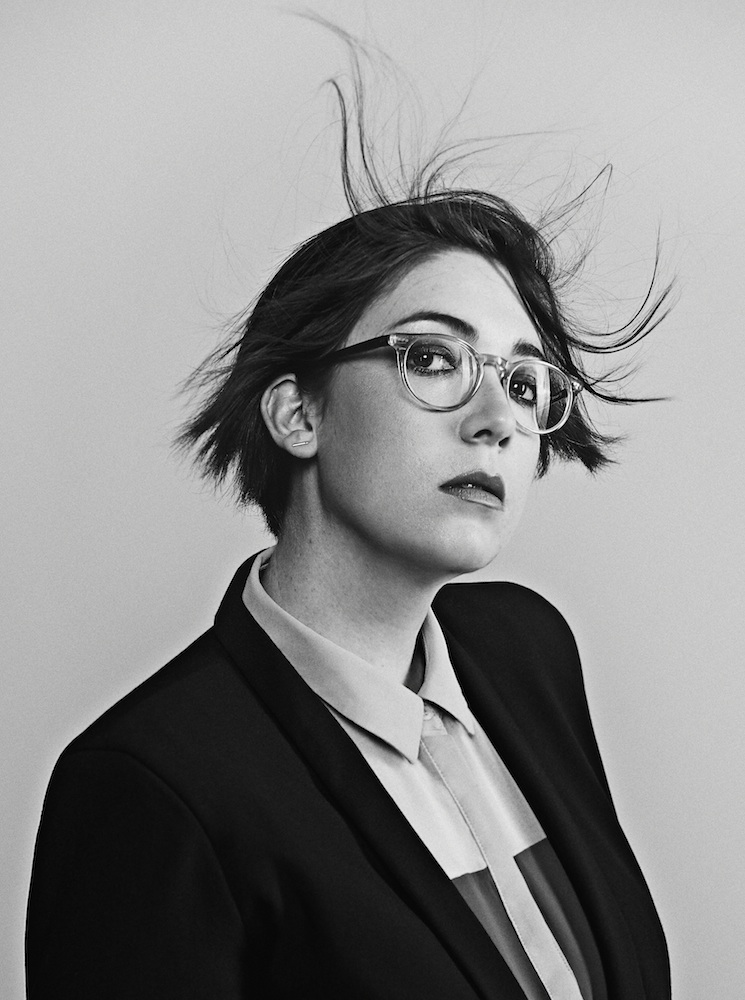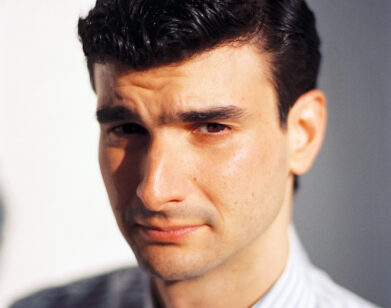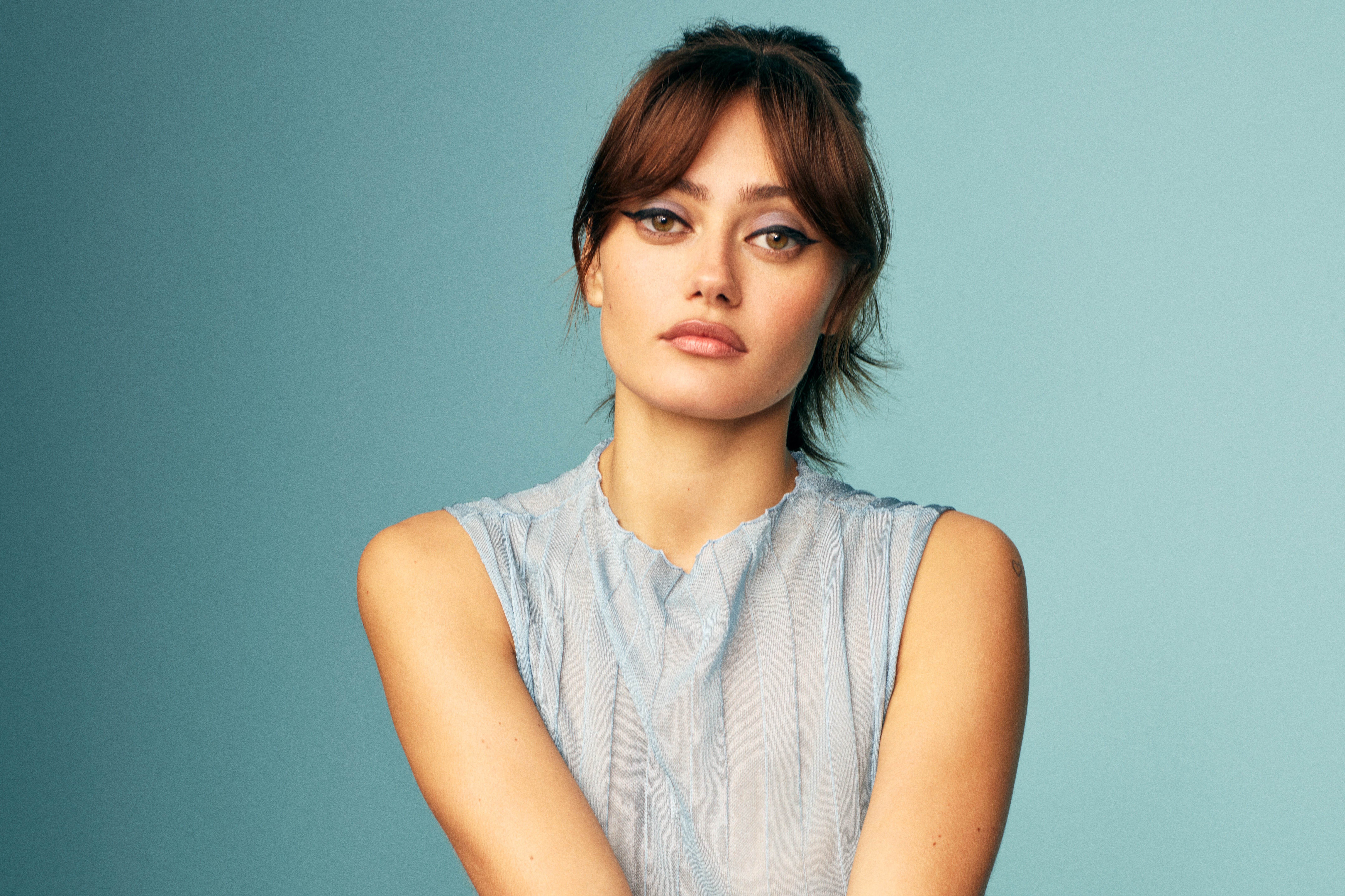Anna Rose Holmer’s Allegorical Adolescence

ANNA ROSE HOLMER IN NEW YORK, MAY 2016. PORTRAIT: WENJUN LIANG. HAIR AND MAKEUP: MAHFUD IBRAHIM/EXCLUSIVE ARTISTS MANAGEMENT USING ORIBE HAIR CARE AND DIOR BEAUTY.
Puberty is not a pretty thing, but The Fits, directed by newcomer Anna Rose Holmer, is a beautiful, lyrical portrayal of that liminal moment between girl- and teenage-hood. When we first meet 11-year-old Toni (played by Royalty Hightower, another new face), she is doing sit-ups in a school boxing gym, her older brother and his friends sparing behind her. But Toni is not content; she is fascinated by the girls’ dance team across the hall. As Toni allows herself to be drawn in, the older girls on the team start experiencing sudden, uncontrollable fits, leaving Toni behind one by one.
Raised in Pawling, New York, by an art teacher mother and piano-tuner father, Holmer went to Quaker school and worked on a farm as a teenager. “I wasn’t a film nerd at all,” she admits at the Interview offices in New York. Around 16, however, two things changed: Holmer started studying photography and watched Mary Ellen Mark and Martin Bell’s nonfiction film Streetwise. When it was time to go to college, Holmer picked NYU with aspirations of becoming a director of photography. “I came to film through photography so I was always looking at the person with the camera,” she says.
Before co-writing The Fits with the film’s co-producer Lisa Kjerulff and editor Saela Davis, Holmer worked her way up the camera department on nonfiction films as a “first” (a first assistant camera) and an operator. “It definitely formally set the tone for my approach to cinema as a very visually rich language,” she reflects. “Your job is to be right next to the camera, so I got to witness the process of a lot of directors working with actors and DPs.”
Funded entirely by grants, The Fits was developed for and through the Venice Biennale’s College – Cinema lab. Holmer and her co-writers discovered the dance team featured in the movie, the Q-Kidz, via YouTube, and went to film them in Cincinnati with their coach as an associate producer. “It was the first time I’d ever seen drill,” she says. “I fell in love with the dance form.”
After premiering at the 2015 Venice Film Festival, selling to Oscilloscope, and making its North American debut at Sundance last January, The Fits is will open in limited release tomorrow.
EMMA BROWN: I know The Fits was developed at the Venice Biennale. How did that come about?
ANNA ROSE HOLMER: I’d heard whisperings about it from other filmmakers. The second year it existed was when I really started thinking about The Fits seriously. I loosely developed it for a year; I brainstormed and was building a Tumblr. Then when the open call came about, we submitted, but the constraints of the micro budget, micro timeline were always something that we had thought about with this project. Choosing to go into that experimental process was really healthy, I think, and was built into the groundwork of the film.
BROWN: When you submitted your application, did you show them the Tumblr?
HOLMER: That was part of it. I’d been working on it with Lisa Kjerulff who’s my co-writer and producer, and Saela Davis, who’s our editor and co-writer. I had just discovered the Q-Kidz while we were submitting, so I started to incorporate drill a little bit into our pitch, but my original conception of the film did not take place with drill. We sent in a Tumblr, kind of an artist’s statement, and a very loose outline, which I think is still the seed of the film. The real thing that we were after was juxtaposing these really intense, precise, intentional movements of dance against the uncontrollable elements of the fits, and putting those as close together as we can in the film. That was there from the very beginning.
BROWN: Did you envision it as more of a visual piece than a character-driven one?
HOLMER: Totally. We came at this always as a dance film, so it was very visually driven, very movement based. A lot of our references were choreography or tone pieces, photographs. All three of us—Lisa, Saela, and myself—are kind of visual storytellers, and Toni as a character started to blossom in the development process with the Biennale. She was there from the beginning, she was always the main character, but it really zeroed in as a story about her as opposed to a story about the fits. I think there’s a lot of me, Lisa, and Saela in Toni, and putting ourselves out there on the page was part of that process.
BROWN: How did you find Royalty Hightower, who plays Toni in the film?
HOLMER: Royalty is incredible. One of the early ideas for the film was that we wanted to cast all the girls from the same dance team, so when we went out to cast, we were really casting a team first, and then looking for the parts within that. We weren’t sure if that meant we would find Toni as well. Royalty was like the eighth girl we saw—really early. I’d heard so many horror stories about kid casting, and she just blew me away. It wasn’t that she did this spectacular read or really emotional monologue; it was more about her presence as a person in the room. She was really introspective, kind of an old soul. And the connection that we had was really special. I just immediately wanted to collaborate with her as a performer.
[It was] the same thing with Alexis [Neblett], who plays Beezy. Alexis walked into the room and I felt like I met Beezy. She just was pure joy, no judgment, like a sprite or a fairy or a clown sometimes. That kind of levity Beezy developed over the course of writing, but by the time we got to casting, we were looking for someone who had that freedom and joy already. Alexis is exactly like Beezy. She is that person every single day. She has this incredible comedic timing in the way that she dances and moves. I think she made Beezy even more funny than she was on the page.
BROWN: Throughout the film there are these beats where it feels like something really terrible is going to happen. How did you map those out?
HOLMER: Our script was pretty formal in terms of the structure, especially in the progression of the fits and what they meant and how they changed as Toni changed. That playing around with tension, was something that Saela, our sound designer Chris Foster, and our composers Danny and Saunder, we all worked together to say, “We want to point towards this moment as being full of tension. What tools do we have?” A lot of that was built into the camera work, but accenting or punctuating those was something that we did with sound design and music.
BROWN: Did it take you a long time to edit the film?
HOLMER: We only edited for 12 weeks, which was kind of insane, but Saela was also one of our writers, so we were kind of ahead of the game in that way. We wrote a very lean script knowing that we were going into this accelerated post timeline because of the pressure of Venice. In the end, I think the hardest part about the timeline for me was post, just ’cause you need a week a way. Looking at it every day, it’s kind of hard to see it. We relied a lot on our peers and some mentors to help zoom out and look at what we were doing.
BROWN: Who were some of your mentors?
HOLMER: We worked with Mary Stephen, who was an editor. She cut Last Train Home, which is one of my favorite nonfiction films in a long time. She was part of the Venice Biennale program and she saw some very early cuts. Then we went to Sundance and did their inaugural edit lab. Saela and I went up there for a week and Lee Percy was our advisor and Dylan Tichenor, Kasi Lemmons, and Michelle Satter who’s there. We tried to get it in front of as many people we respected as possible, and then our peer group was also holding us accountable.
BROWN: I assume Royalty’s seen the film.
HOLMER: Royalty watches it every time we go to a festival. I want to not watch it, and she wants to watch it over and over and over.
BROWN: I wonder how girls her age who are sort of going through what Toni did at this moment would respond to the film.
HOLMER: We’ve been doing a lot of student screenings—a little older. We screened for the Q-Kidz and five-year-olds watched the film. Sometimes maybe they think it’s funnier than we do, but I’ve been pretty amazed by the response from adolescents and teens, who just buy into the magical realism aspect of the film with a lot fewer caveats. Also just the questions and what they’re looking at and focusing on is different. I like that the film lives in those spaces. I hope it can. When we did the screening for the girls and boys, it was one of the most emotional screenings I’ve ever been to, because the credits go down and the lionesses’ chant comes up and they all started chanting along and I was just weeping. It was really special to share with them. Royalty can’t wait for a DVD so she can watch it again and again.
BROWN: It seemed like it was a very collaborative process with The Fits. Did you ever have disagreements with your co-writers?
HOLMER: Totally. That was one of the most beautiful things about it. The film is stronger because we fought it out. It definitely wasn’t screaming or yelling, and there were times when I had to say, “This is my decision” and we moved forward, but even in those scenarios, I was forced to articulate and defend my vision. For the most part, we all felt like we were building the same thing. I was worried going in that somehow my producer brain and my director brain would be at odds, and pretty quickly it was clear that I could only be there director on set. You’re required to be this very open book, very vulnerable—when you’re dealing with kids, any kind of false intention is read immediately—so I had to be engaged in this really emotional way all the time. I learned a lot about what real leadership on set is in that you really set the tone as the director for the energy of every single day. That hit me for the first time, what it means to direct. There was one day where I was pretty sick and I saw how I was feeling on the faces of all my crew, and I was like, “Okay, you rally because you’re bringing everyone down and that’s irresponsible.” In terms of directing actors, each of the kids in our film had never been in a film before; they didn’t know what type of actor they were, so one of the big challenges was working with them to figure out what type of method they wanted to use. Seeing how varied and how different they approached the process was pretty special.
BROWN: I know you’re working on your second film, is there a lot of pressure to have a bigger budget and famous actors and all of that?
HOLMER: I think there’s pressure, but also the way that we made The Fits is certainly not a sustainable model. I want people who work on my films to make a living creatively and I want to also reach as wide of an audience as possible. Some of that is just a balance of understanding how films get out in the world, and I don’t think it’s necessarily pressure to go big for no reason. Limitations really helped us with The Fits, but there were also things that we just couldn’t do because of our budget or timeline. Creatively, I want to be able to flex my muscle in whatever way is needed for the content, and if that means growing, I don’t think it’s a bad thing.
BROWN: What do you think is missing in the film landscape today? What kind of stories do you want to tell?
HOLMER: There’s tons of stuff that’s missing, especially in terms of what becomes commercially viable, it’s such a narrow focus, a narrow gaze. In general, I think there needs to be a shakeup of what eventually gets to those wide audiences. I’m interested in stories that make me question what it means to be human and engage with other people. Some of that is about subverting and provoking, but sometimes it’s just about what it means to be vulnerable in front of another human being.
THE FITS COMES OUT IN LIMITED RELEASE TOMORROW, JUNE 3.






